Innovation within a Small Business Context: Chilly's Report Analysis
VerifiedAdded on 2023/01/19
|19
|6612
|100
Report
AI Summary
This report provides a comprehensive analysis of innovation within a small business context, focusing on Chilly's as a case study. The introduction outlines the importance of innovation and distinguishes it from invention, setting the stage for an exploration of Chilly's strategies. Task 1 delves into the significance of innovation, emphasizing its role in gaining a competitive edge, maximizing ROI, and fostering research and development. It examines the interplay of organizational vision, leadership, culture, and teamwork in shaping innovation and commercialization. The report then analyzes various sources of innovation, including uncertainty, industrial changes, and demographics, and explores how Chilly's can cultivate an environment that fosters innovation. Task 2 examines the 4Ps of innovation (Paradigm, Process, Product, and Position) and the application of the innovation funnel. It covers developments in frugal innovation and analyzes the innovation funnel in relation to Chilly's business. Task 3 focuses on the commercial funnel, new product development, and the creation of an innovation business case. It also discusses measures for testing, iteration, and improvement. Task 4 evaluates tools for developing, retaining, and protecting intellectual property, assessing these tools within the broader business environment. Finally, the report offers a critical evaluation of the nature of innovation, drawing conclusions based on the analysis of Chilly's strategies.
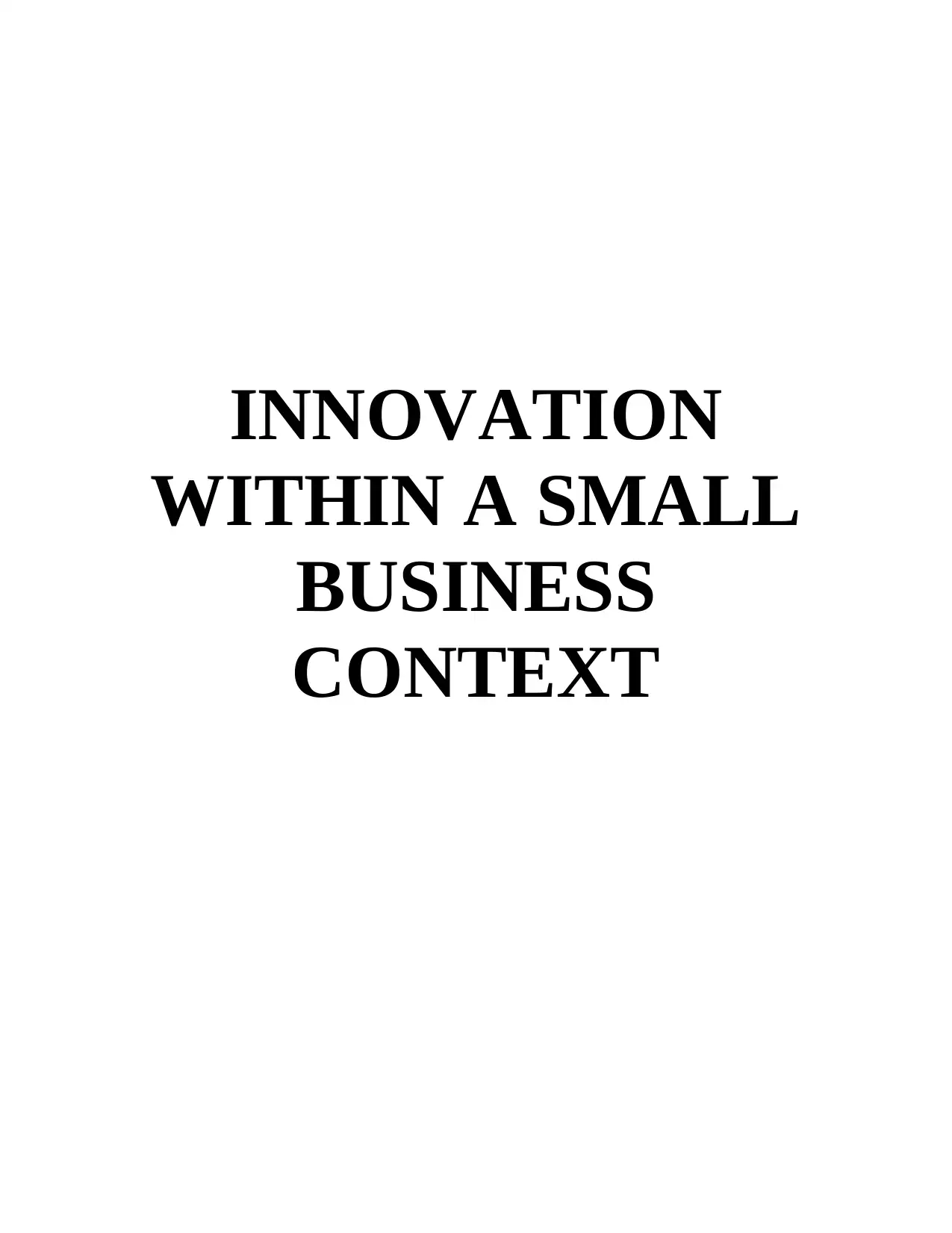
INNOVATION
WITHIN A SMALL
BUSINESS
CONTEXT
WITHIN A SMALL
BUSINESS
CONTEXT
Paraphrase This Document
Need a fresh take? Get an instant paraphrase of this document with our AI Paraphraser

Table of Contents
INTRODUCTION...........................................................................................................................1
TASK 1............................................................................................................................................1
P1. Innovation and its importance in comparison with invention..........................................1
P2. Role of organisational vision, leadership, culture and teamwork on shaping innovation and
commercialisation...................................................................................................................3
M1. Analysis of different sources of innovation....................................................................4
TASK 2............................................................................................................................................5
P3. 4P's of innovation and innovation funnel usage...............................................................5
P4. Developments in Frugal Innovation.................................................................................6
M2. Analysis and application of Innovation Funnel..............................................................7
M3. Evaluation of role of Frugal Innovation..........................................................................7
D1. Critical Analysis of how innovation is developed, embedded and measured.................8
TASK 3............................................................................................................................................8
P5. Importance of commercial Funnel and Application of New Produce Development.......8
P6. Innovation Business Case...............................................................................................10
M4. Measures to test, iterate and improve...........................................................................11
TASK 4..........................................................................................................................................12
P7. Evaluation of Different tools to develop, retain and protect intellectual property.........12
M5. Evaluation of tools in context of wider business environment.....................................13
D2. Critical Evaluation of nature of innovation...................................................................14
CONCLUSION..............................................................................................................................14
REFERENCES..............................................................................................................................16
INTRODUCTION...........................................................................................................................1
TASK 1............................................................................................................................................1
P1. Innovation and its importance in comparison with invention..........................................1
P2. Role of organisational vision, leadership, culture and teamwork on shaping innovation and
commercialisation...................................................................................................................3
M1. Analysis of different sources of innovation....................................................................4
TASK 2............................................................................................................................................5
P3. 4P's of innovation and innovation funnel usage...............................................................5
P4. Developments in Frugal Innovation.................................................................................6
M2. Analysis and application of Innovation Funnel..............................................................7
M3. Evaluation of role of Frugal Innovation..........................................................................7
D1. Critical Analysis of how innovation is developed, embedded and measured.................8
TASK 3............................................................................................................................................8
P5. Importance of commercial Funnel and Application of New Produce Development.......8
P6. Innovation Business Case...............................................................................................10
M4. Measures to test, iterate and improve...........................................................................11
TASK 4..........................................................................................................................................12
P7. Evaluation of Different tools to develop, retain and protect intellectual property.........12
M5. Evaluation of tools in context of wider business environment.....................................13
D2. Critical Evaluation of nature of innovation...................................................................14
CONCLUSION..............................................................................................................................14
REFERENCES..............................................................................................................................16

INTRODUCTION
Innovation refers to the procedure which is adopted by companies in order to introduce a
distinct and useful feature within their existing offerings in the market. The agenda behind the
same is to enhance the usefulness and importance of the product and service in context of its
functioning and scope (Chun and et. al., 2015). Moreover, innovation is also necessary for
organisations in order to appropriately and effectively gain a competitive advantage and long
term sustainability in the niche as well as potential markets. The report below is based on
Chilly's, which is one of the most effective and recognised organisations within the UK.
Moreover, the mission of the firm is to create offerings for an active urban lifestyle and ensure
inclination towards everyday use of reusable products. The company is currently planning to
expand its product line to remaining competitive. Hence, the report covers explanation in context
for innovation and determination of difference between invention and innovation. Moreover, it
also covers explanation of different types of innovation along with discussion of processes
required to commercialise innovation, within Chilly's. Furthermore, the assessment also
evaluates range of methods for protecting ideas and understand their advantages and
disadvantages.
TASK 1
P1. Innovation and its importance in comparison with invention
Invention is the procedure of creation of a completely new offering, which has never
been created before. Furthermore, it is the process through which either a new demand in the
market is created, or an existing demand is resolved. Moreover, this aspect is a core development
of ideas and experiences of an individual or group, into a unique and valuable offering
(Rasmussen. and Eliason, 2017).
On the other hand, innovation is appropriately adopted in bringing in improvements and
addition in features within a firm's existing products and services. However, there are several
points of its importance, to reflect value of innovation within a company, which are mentioned
below: Competitive Edge: One of the major aspects which reflects importance of innovation is
related to gaining a competitive edge within the market. This is because it enhances the
1
Innovation refers to the procedure which is adopted by companies in order to introduce a
distinct and useful feature within their existing offerings in the market. The agenda behind the
same is to enhance the usefulness and importance of the product and service in context of its
functioning and scope (Chun and et. al., 2015). Moreover, innovation is also necessary for
organisations in order to appropriately and effectively gain a competitive advantage and long
term sustainability in the niche as well as potential markets. The report below is based on
Chilly's, which is one of the most effective and recognised organisations within the UK.
Moreover, the mission of the firm is to create offerings for an active urban lifestyle and ensure
inclination towards everyday use of reusable products. The company is currently planning to
expand its product line to remaining competitive. Hence, the report covers explanation in context
for innovation and determination of difference between invention and innovation. Moreover, it
also covers explanation of different types of innovation along with discussion of processes
required to commercialise innovation, within Chilly's. Furthermore, the assessment also
evaluates range of methods for protecting ideas and understand their advantages and
disadvantages.
TASK 1
P1. Innovation and its importance in comparison with invention
Invention is the procedure of creation of a completely new offering, which has never
been created before. Furthermore, it is the process through which either a new demand in the
market is created, or an existing demand is resolved. Moreover, this aspect is a core development
of ideas and experiences of an individual or group, into a unique and valuable offering
(Rasmussen. and Eliason, 2017).
On the other hand, innovation is appropriately adopted in bringing in improvements and
addition in features within a firm's existing products and services. However, there are several
points of its importance, to reflect value of innovation within a company, which are mentioned
below: Competitive Edge: One of the major aspects which reflects importance of innovation is
related to gaining a competitive edge within the market. This is because it enhances the
1
⊘ This is a preview!⊘
Do you want full access?
Subscribe today to unlock all pages.

Trusted by 1+ million students worldwide
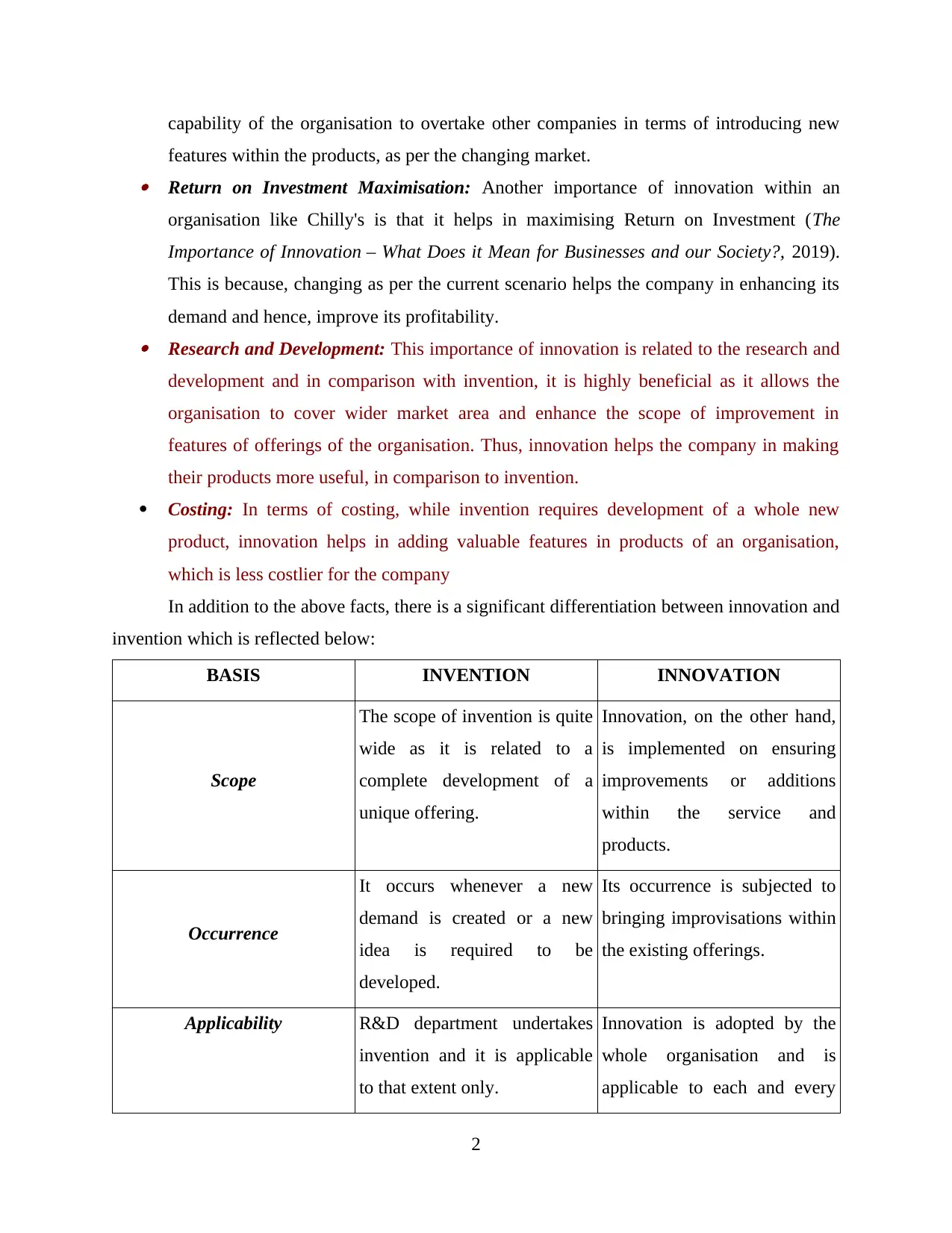
capability of the organisation to overtake other companies in terms of introducing new
features within the products, as per the changing market. Return on Investment Maximisation: Another importance of innovation within an
organisation like Chilly's is that it helps in maximising Return on Investment (The
Importance of Innovation – What Does it Mean for Businesses and our Society?, 2019).
This is because, changing as per the current scenario helps the company in enhancing its
demand and hence, improve its profitability. Research and Development: This importance of innovation is related to the research and
development and in comparison with invention, it is highly beneficial as it allows the
organisation to cover wider market area and enhance the scope of improvement in
features of offerings of the organisation. Thus, innovation helps the company in making
their products more useful, in comparison to invention.
Costing: In terms of costing, while invention requires development of a whole new
product, innovation helps in adding valuable features in products of an organisation,
which is less costlier for the company
In addition to the above facts, there is a significant differentiation between innovation and
invention which is reflected below:
BASIS INVENTION INNOVATION
Scope
The scope of invention is quite
wide as it is related to a
complete development of a
unique offering.
Innovation, on the other hand,
is implemented on ensuring
improvements or additions
within the service and
products.
Occurrence
It occurs whenever a new
demand is created or a new
idea is required to be
developed.
Its occurrence is subjected to
bringing improvisations within
the existing offerings.
Applicability R&D department undertakes
invention and it is applicable
to that extent only.
Innovation is adopted by the
whole organisation and is
applicable to each and every
2
features within the products, as per the changing market. Return on Investment Maximisation: Another importance of innovation within an
organisation like Chilly's is that it helps in maximising Return on Investment (The
Importance of Innovation – What Does it Mean for Businesses and our Society?, 2019).
This is because, changing as per the current scenario helps the company in enhancing its
demand and hence, improve its profitability. Research and Development: This importance of innovation is related to the research and
development and in comparison with invention, it is highly beneficial as it allows the
organisation to cover wider market area and enhance the scope of improvement in
features of offerings of the organisation. Thus, innovation helps the company in making
their products more useful, in comparison to invention.
Costing: In terms of costing, while invention requires development of a whole new
product, innovation helps in adding valuable features in products of an organisation,
which is less costlier for the company
In addition to the above facts, there is a significant differentiation between innovation and
invention which is reflected below:
BASIS INVENTION INNOVATION
Scope
The scope of invention is quite
wide as it is related to a
complete development of a
unique offering.
Innovation, on the other hand,
is implemented on ensuring
improvements or additions
within the service and
products.
Occurrence
It occurs whenever a new
demand is created or a new
idea is required to be
developed.
Its occurrence is subjected to
bringing improvisations within
the existing offerings.
Applicability R&D department undertakes
invention and it is applicable
to that extent only.
Innovation is adopted by the
whole organisation and is
applicable to each and every
2
Paraphrase This Document
Need a fresh take? Get an instant paraphrase of this document with our AI Paraphraser

department.
P2. Role of organisational vision, leadership, culture and teamwork on shaping innovation and
commercialisation
Commercialisation is the process of introducing an offering effectively within the market
and making the same familiar amongst existing, as well as, potential customers (Ke and et. al.,
2016). Innovation and Commercialisation within an organisation like Chilly's go hand in hand,
wherein, one is related to ensuring betterment in the firm's offerings, the other works on
communication of the same within the market.
However, there are certain elements which shape innovation and commercialisation
within Chilly's. These factors are discussed below: Vision: One of the major aspects that play a role within shaping innovation and
commercialisation within an organisation is its vision (Datta, Mukherjee and Jessup,
2015). For instance, an organisation aiming at surviving would not indulge itself much
into innovation and commercialisation. However, vision of Chilly's is to provide people
to have cold water on the go and to reduce the use of single-use plastic water bottles. In
context with Innovation, this shapes up the company's working towards developing better
alternatives to accomplish the vision. Moreover, whereas Commercialisation is
concerned, developing reusable items, with effective durability in context with purity of
water, would be enhancing the company's reputation and thus, ensuring its inclination
towards developing dynamic and better offerings. Leadership: Another factor responsible to shaping innovation and commercialisation is
Leadership. In Chilly's the leadership has always been implemented to improve
performance of the company and its offerings. Thus, both environmental and mechanical
sciences are applied with use of technology in context with development of their
products. Such encouragement and motivation towards development, shapes innovation
effectively as training is given to employees to enhance their creativity and ensure
continuous improvement in the organisation. Moreover, in relation to commercialisation,
emphasis of leadership towards improvement ensures better edge within the market and
more preference amongst customers.
3
P2. Role of organisational vision, leadership, culture and teamwork on shaping innovation and
commercialisation
Commercialisation is the process of introducing an offering effectively within the market
and making the same familiar amongst existing, as well as, potential customers (Ke and et. al.,
2016). Innovation and Commercialisation within an organisation like Chilly's go hand in hand,
wherein, one is related to ensuring betterment in the firm's offerings, the other works on
communication of the same within the market.
However, there are certain elements which shape innovation and commercialisation
within Chilly's. These factors are discussed below: Vision: One of the major aspects that play a role within shaping innovation and
commercialisation within an organisation is its vision (Datta, Mukherjee and Jessup,
2015). For instance, an organisation aiming at surviving would not indulge itself much
into innovation and commercialisation. However, vision of Chilly's is to provide people
to have cold water on the go and to reduce the use of single-use plastic water bottles. In
context with Innovation, this shapes up the company's working towards developing better
alternatives to accomplish the vision. Moreover, whereas Commercialisation is
concerned, developing reusable items, with effective durability in context with purity of
water, would be enhancing the company's reputation and thus, ensuring its inclination
towards developing dynamic and better offerings. Leadership: Another factor responsible to shaping innovation and commercialisation is
Leadership. In Chilly's the leadership has always been implemented to improve
performance of the company and its offerings. Thus, both environmental and mechanical
sciences are applied with use of technology in context with development of their
products. Such encouragement and motivation towards development, shapes innovation
effectively as training is given to employees to enhance their creativity and ensure
continuous improvement in the organisation. Moreover, in relation to commercialisation,
emphasis of leadership towards improvement ensures better edge within the market and
more preference amongst customers.
3
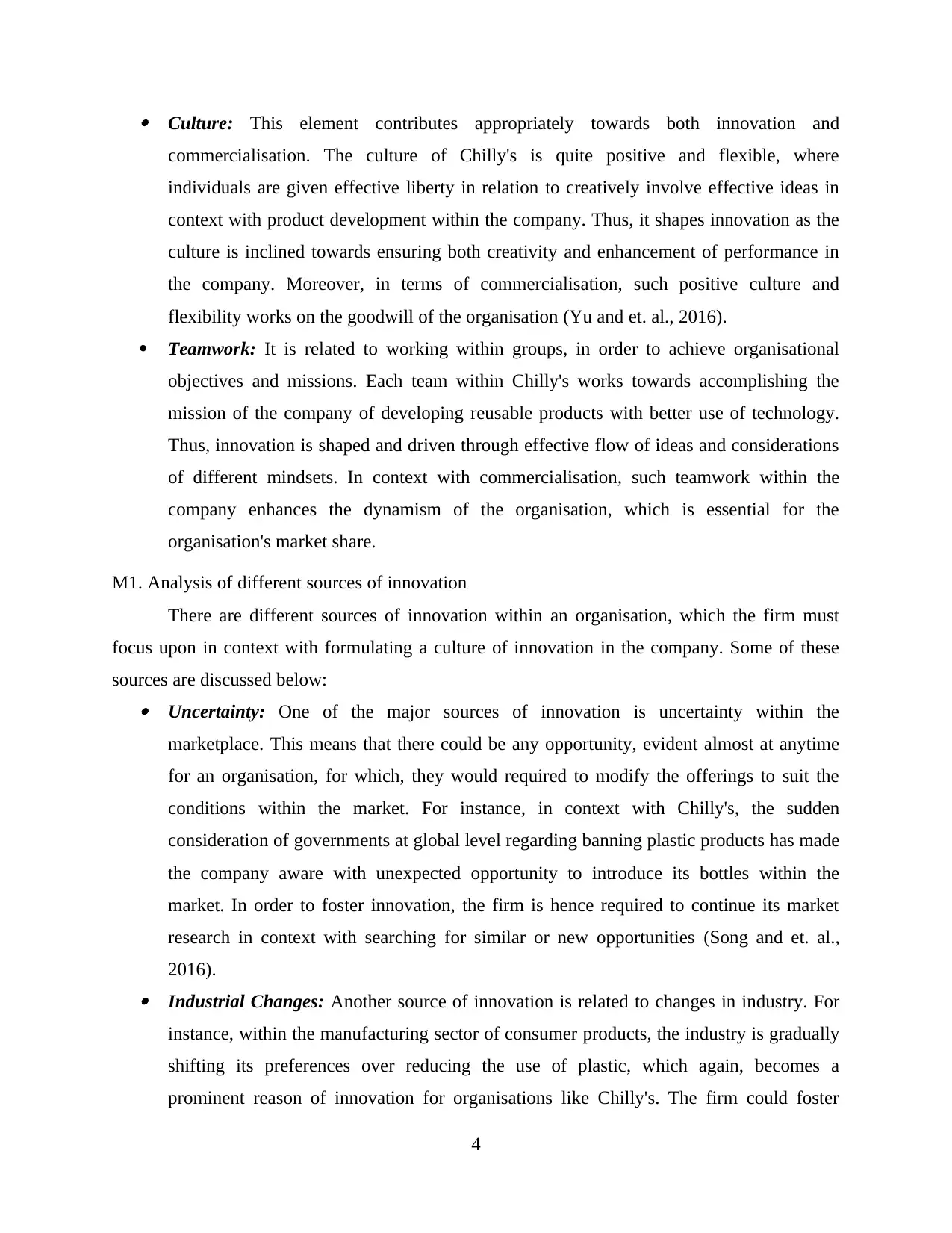
Culture: This element contributes appropriately towards both innovation and
commercialisation. The culture of Chilly's is quite positive and flexible, where
individuals are given effective liberty in relation to creatively involve effective ideas in
context with product development within the company. Thus, it shapes innovation as the
culture is inclined towards ensuring both creativity and enhancement of performance in
the company. Moreover, in terms of commercialisation, such positive culture and
flexibility works on the goodwill of the organisation (Yu and et. al., 2016).
Teamwork: It is related to working within groups, in order to achieve organisational
objectives and missions. Each team within Chilly's works towards accomplishing the
mission of the company of developing reusable products with better use of technology.
Thus, innovation is shaped and driven through effective flow of ideas and considerations
of different mindsets. In context with commercialisation, such teamwork within the
company enhances the dynamism of the organisation, which is essential for the
organisation's market share.
M1. Analysis of different sources of innovation
There are different sources of innovation within an organisation, which the firm must
focus upon in context with formulating a culture of innovation in the company. Some of these
sources are discussed below: Uncertainty: One of the major sources of innovation is uncertainty within the
marketplace. This means that there could be any opportunity, evident almost at anytime
for an organisation, for which, they would required to modify the offerings to suit the
conditions within the market. For instance, in context with Chilly's, the sudden
consideration of governments at global level regarding banning plastic products has made
the company aware with unexpected opportunity to introduce its bottles within the
market. In order to foster innovation, the firm is hence required to continue its market
research in context with searching for similar or new opportunities (Song and et. al.,
2016). Industrial Changes: Another source of innovation is related to changes in industry. For
instance, within the manufacturing sector of consumer products, the industry is gradually
shifting its preferences over reducing the use of plastic, which again, becomes a
prominent reason of innovation for organisations like Chilly's. The firm could foster
4
commercialisation. The culture of Chilly's is quite positive and flexible, where
individuals are given effective liberty in relation to creatively involve effective ideas in
context with product development within the company. Thus, it shapes innovation as the
culture is inclined towards ensuring both creativity and enhancement of performance in
the company. Moreover, in terms of commercialisation, such positive culture and
flexibility works on the goodwill of the organisation (Yu and et. al., 2016).
Teamwork: It is related to working within groups, in order to achieve organisational
objectives and missions. Each team within Chilly's works towards accomplishing the
mission of the company of developing reusable products with better use of technology.
Thus, innovation is shaped and driven through effective flow of ideas and considerations
of different mindsets. In context with commercialisation, such teamwork within the
company enhances the dynamism of the organisation, which is essential for the
organisation's market share.
M1. Analysis of different sources of innovation
There are different sources of innovation within an organisation, which the firm must
focus upon in context with formulating a culture of innovation in the company. Some of these
sources are discussed below: Uncertainty: One of the major sources of innovation is uncertainty within the
marketplace. This means that there could be any opportunity, evident almost at anytime
for an organisation, for which, they would required to modify the offerings to suit the
conditions within the market. For instance, in context with Chilly's, the sudden
consideration of governments at global level regarding banning plastic products has made
the company aware with unexpected opportunity to introduce its bottles within the
market. In order to foster innovation, the firm is hence required to continue its market
research in context with searching for similar or new opportunities (Song and et. al.,
2016). Industrial Changes: Another source of innovation is related to changes in industry. For
instance, within the manufacturing sector of consumer products, the industry is gradually
shifting its preferences over reducing the use of plastic, which again, becomes a
prominent reason of innovation for organisations like Chilly's. The firm could foster
4
⊘ This is a preview!⊘
Do you want full access?
Subscribe today to unlock all pages.

Trusted by 1+ million students worldwide
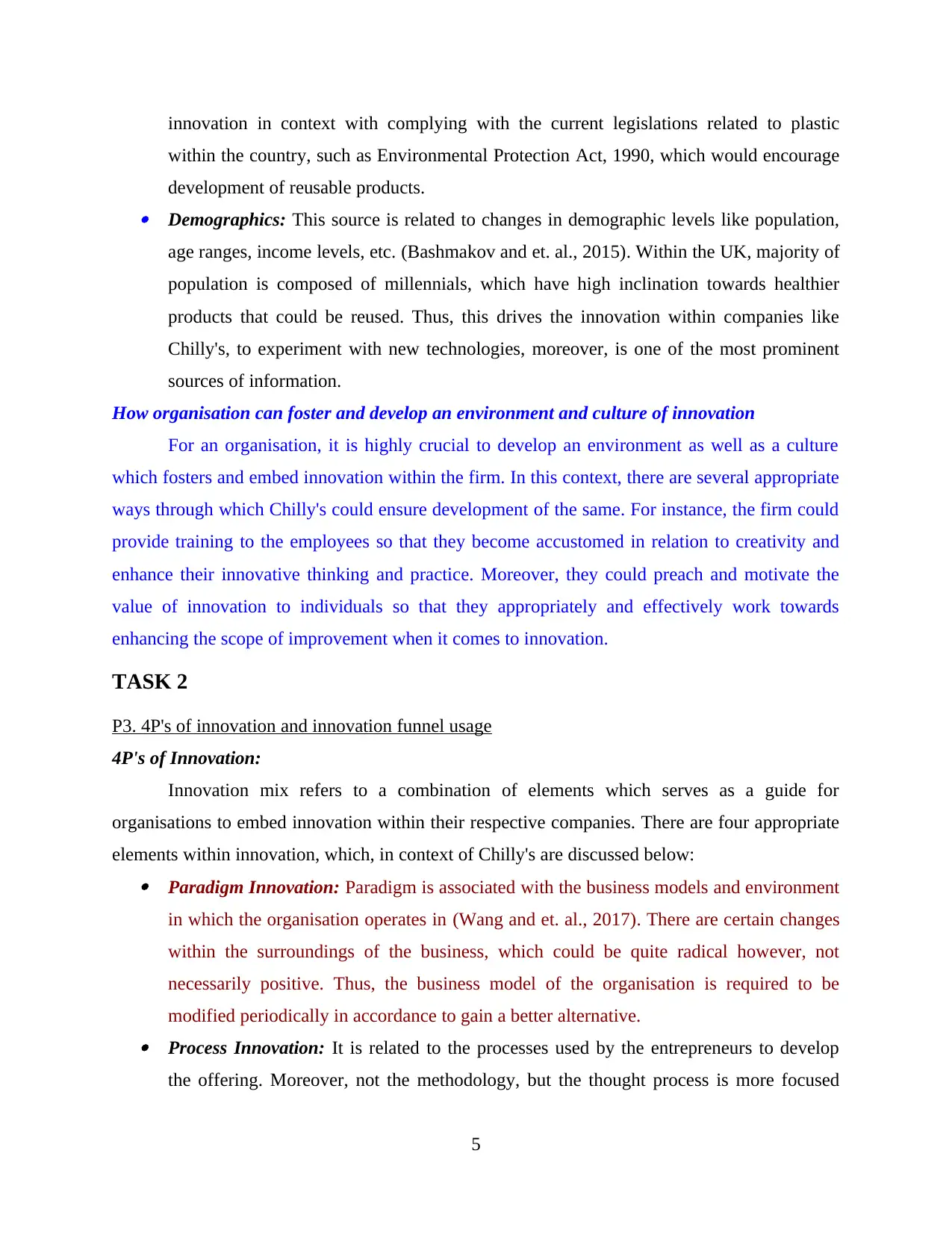
innovation in context with complying with the current legislations related to plastic
within the country, such as Environmental Protection Act, 1990, which would encourage
development of reusable products. Demographics: This source is related to changes in demographic levels like population,
age ranges, income levels, etc. (Bashmakov and et. al., 2015). Within the UK, majority of
population is composed of millennials, which have high inclination towards healthier
products that could be reused. Thus, this drives the innovation within companies like
Chilly's, to experiment with new technologies, moreover, is one of the most prominent
sources of information.
How organisation can foster and develop an environment and culture of innovation
For an organisation, it is highly crucial to develop an environment as well as a culture
which fosters and embed innovation within the firm. In this context, there are several appropriate
ways through which Chilly's could ensure development of the same. For instance, the firm could
provide training to the employees so that they become accustomed in relation to creativity and
enhance their innovative thinking and practice. Moreover, they could preach and motivate the
value of innovation to individuals so that they appropriately and effectively work towards
enhancing the scope of improvement when it comes to innovation.
TASK 2
P3. 4P's of innovation and innovation funnel usage
4P's of Innovation:
Innovation mix refers to a combination of elements which serves as a guide for
organisations to embed innovation within their respective companies. There are four appropriate
elements within innovation, which, in context of Chilly's are discussed below: Paradigm Innovation: Paradigm is associated with the business models and environment
in which the organisation operates in (Wang and et. al., 2017). There are certain changes
within the surroundings of the business, which could be quite radical however, not
necessarily positive. Thus, the business model of the organisation is required to be
modified periodically in accordance to gain a better alternative. Process Innovation: It is related to the processes used by the entrepreneurs to develop
the offering. Moreover, not the methodology, but the thought process is more focused
5
within the country, such as Environmental Protection Act, 1990, which would encourage
development of reusable products. Demographics: This source is related to changes in demographic levels like population,
age ranges, income levels, etc. (Bashmakov and et. al., 2015). Within the UK, majority of
population is composed of millennials, which have high inclination towards healthier
products that could be reused. Thus, this drives the innovation within companies like
Chilly's, to experiment with new technologies, moreover, is one of the most prominent
sources of information.
How organisation can foster and develop an environment and culture of innovation
For an organisation, it is highly crucial to develop an environment as well as a culture
which fosters and embed innovation within the firm. In this context, there are several appropriate
ways through which Chilly's could ensure development of the same. For instance, the firm could
provide training to the employees so that they become accustomed in relation to creativity and
enhance their innovative thinking and practice. Moreover, they could preach and motivate the
value of innovation to individuals so that they appropriately and effectively work towards
enhancing the scope of improvement when it comes to innovation.
TASK 2
P3. 4P's of innovation and innovation funnel usage
4P's of Innovation:
Innovation mix refers to a combination of elements which serves as a guide for
organisations to embed innovation within their respective companies. There are four appropriate
elements within innovation, which, in context of Chilly's are discussed below: Paradigm Innovation: Paradigm is associated with the business models and environment
in which the organisation operates in (Wang and et. al., 2017). There are certain changes
within the surroundings of the business, which could be quite radical however, not
necessarily positive. Thus, the business model of the organisation is required to be
modified periodically in accordance to gain a better alternative. Process Innovation: It is related to the processes used by the entrepreneurs to develop
the offering. Moreover, not the methodology, but the thought process is more focused
5
Paraphrase This Document
Need a fresh take? Get an instant paraphrase of this document with our AI Paraphraser
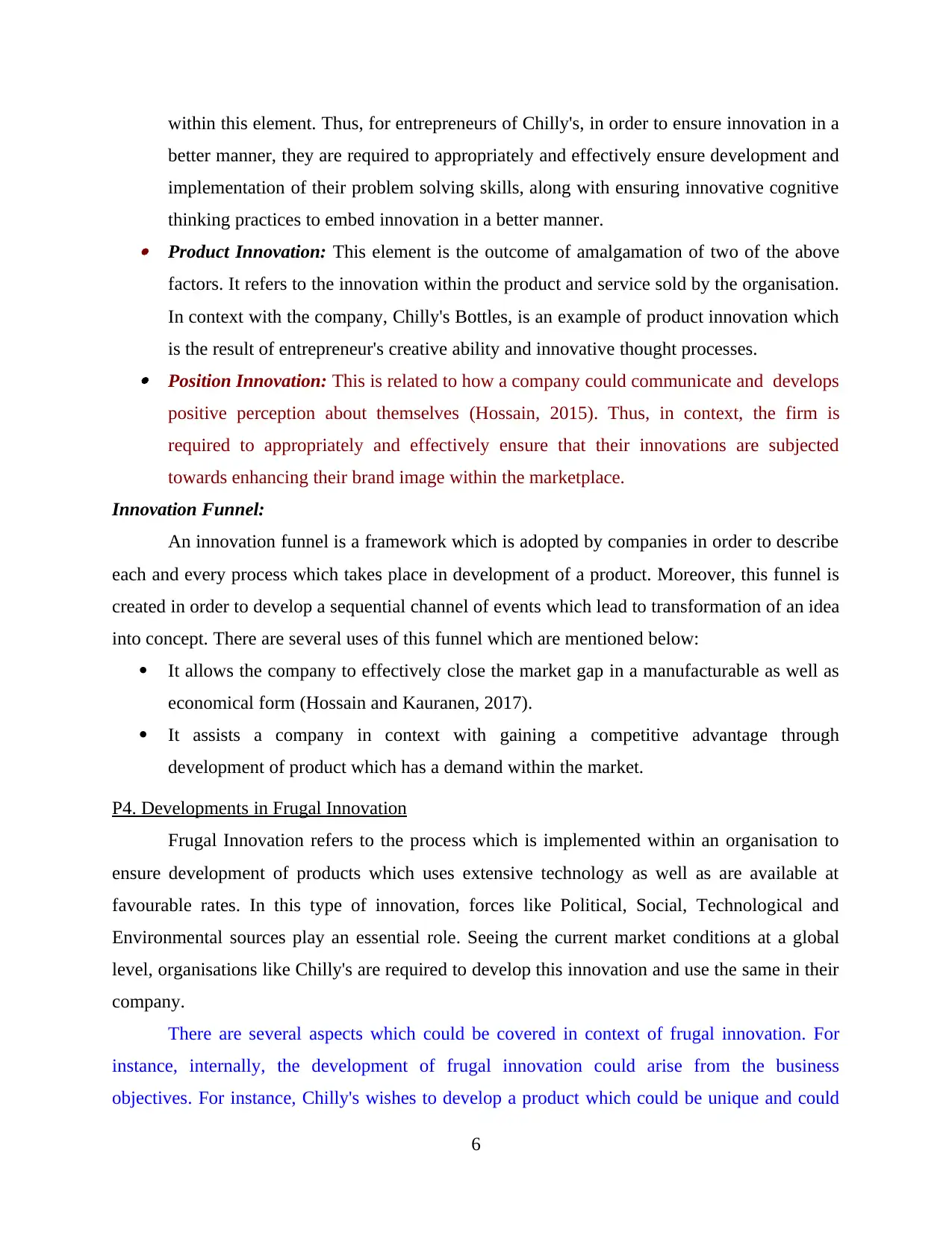
within this element. Thus, for entrepreneurs of Chilly's, in order to ensure innovation in a
better manner, they are required to appropriately and effectively ensure development and
implementation of their problem solving skills, along with ensuring innovative cognitive
thinking practices to embed innovation in a better manner. Product Innovation: This element is the outcome of amalgamation of two of the above
factors. It refers to the innovation within the product and service sold by the organisation.
In context with the company, Chilly's Bottles, is an example of product innovation which
is the result of entrepreneur's creative ability and innovative thought processes. Position Innovation: This is related to how a company could communicate and develops
positive perception about themselves (Hossain, 2015). Thus, in context, the firm is
required to appropriately and effectively ensure that their innovations are subjected
towards enhancing their brand image within the marketplace.
Innovation Funnel:
An innovation funnel is a framework which is adopted by companies in order to describe
each and every process which takes place in development of a product. Moreover, this funnel is
created in order to develop a sequential channel of events which lead to transformation of an idea
into concept. There are several uses of this funnel which are mentioned below:
It allows the company to effectively close the market gap in a manufacturable as well as
economical form (Hossain and Kauranen, 2017).
It assists a company in context with gaining a competitive advantage through
development of product which has a demand within the market.
P4. Developments in Frugal Innovation
Frugal Innovation refers to the process which is implemented within an organisation to
ensure development of products which uses extensive technology as well as are available at
favourable rates. In this type of innovation, forces like Political, Social, Technological and
Environmental sources play an essential role. Seeing the current market conditions at a global
level, organisations like Chilly's are required to develop this innovation and use the same in their
company.
There are several aspects which could be covered in context of frugal innovation. For
instance, internally, the development of frugal innovation could arise from the business
objectives. For instance, Chilly's wishes to develop a product which could be unique and could
6
better manner, they are required to appropriately and effectively ensure development and
implementation of their problem solving skills, along with ensuring innovative cognitive
thinking practices to embed innovation in a better manner. Product Innovation: This element is the outcome of amalgamation of two of the above
factors. It refers to the innovation within the product and service sold by the organisation.
In context with the company, Chilly's Bottles, is an example of product innovation which
is the result of entrepreneur's creative ability and innovative thought processes. Position Innovation: This is related to how a company could communicate and develops
positive perception about themselves (Hossain, 2015). Thus, in context, the firm is
required to appropriately and effectively ensure that their innovations are subjected
towards enhancing their brand image within the marketplace.
Innovation Funnel:
An innovation funnel is a framework which is adopted by companies in order to describe
each and every process which takes place in development of a product. Moreover, this funnel is
created in order to develop a sequential channel of events which lead to transformation of an idea
into concept. There are several uses of this funnel which are mentioned below:
It allows the company to effectively close the market gap in a manufacturable as well as
economical form (Hossain and Kauranen, 2017).
It assists a company in context with gaining a competitive advantage through
development of product which has a demand within the market.
P4. Developments in Frugal Innovation
Frugal Innovation refers to the process which is implemented within an organisation to
ensure development of products which uses extensive technology as well as are available at
favourable rates. In this type of innovation, forces like Political, Social, Technological and
Environmental sources play an essential role. Seeing the current market conditions at a global
level, organisations like Chilly's are required to develop this innovation and use the same in their
company.
There are several aspects which could be covered in context of frugal innovation. For
instance, internally, the development of frugal innovation could arise from the business
objectives. For instance, Chilly's wishes to develop a product which could be unique and could
6

be sold at a prominent rate, which could appropriately be commenced due to ensuring reduction
in complexities of the product. Hence, frugal innovation could then be implemented to fulfil the
objectives. Furthermore, this could be subjected upon the product or the processes of the
organisation, depending upon the intensity of innovation.
Its development could be appropriately judged from the changes taking places within the
society. In relation to the company, one aspect is the constraints evident in context with the
environment, for example, reduction of usage of plastic products. Moreover, another
development is seen through enhanced technological platforms. For instance, Sanipolymers are
being used appropriately in order to ensure purity of water in packaging (Is zinc the key to
antimicrobial packaging?, 2019). Hence, in order to ensure compliance with this constraints,
Chilly's is required to use frugal innovation in expansion of its products.
M2. Analysis and application of Innovation Funnel
As explained above, Innovation Funnel is quite useful for organisation like Chilly's in
providing a pathway to development of new product. Hence, its analysis and application in
context with the organisation are discussed: Assessment of Opportunity: This stage is associated with performing market research,
with the motive of assessing the marketplace in terms of opportunities available for the
company. Questionnaires or surveys could be used by the firm within this stage to
acquire knowledge of the marketplace. Ideation Process: Ideation of distinct products is the basis of this step, which allows the
firm in capitalisation of all the opportunities mentioned above. Brainstorming could be
performed by Chilly's in context of ensuring ideation of different products for the product
line. Conceptualisation: Within this steps, designs are developed in context with the product
design, as well as effective development of features, along with appropriate
configurations. Hence, the company could develop distinct designs of the type of bottles
they would like to develop (Kuratko, and Hoskinson, 2016). Benchmarking: Screening of ideas and concepts sets up the basis for this stage, on the
basis of perceived benefits. Performance Testing could be used by Chilly's to measure the
ideas in terms of profitability and sales.
7
in complexities of the product. Hence, frugal innovation could then be implemented to fulfil the
objectives. Furthermore, this could be subjected upon the product or the processes of the
organisation, depending upon the intensity of innovation.
Its development could be appropriately judged from the changes taking places within the
society. In relation to the company, one aspect is the constraints evident in context with the
environment, for example, reduction of usage of plastic products. Moreover, another
development is seen through enhanced technological platforms. For instance, Sanipolymers are
being used appropriately in order to ensure purity of water in packaging (Is zinc the key to
antimicrobial packaging?, 2019). Hence, in order to ensure compliance with this constraints,
Chilly's is required to use frugal innovation in expansion of its products.
M2. Analysis and application of Innovation Funnel
As explained above, Innovation Funnel is quite useful for organisation like Chilly's in
providing a pathway to development of new product. Hence, its analysis and application in
context with the organisation are discussed: Assessment of Opportunity: This stage is associated with performing market research,
with the motive of assessing the marketplace in terms of opportunities available for the
company. Questionnaires or surveys could be used by the firm within this stage to
acquire knowledge of the marketplace. Ideation Process: Ideation of distinct products is the basis of this step, which allows the
firm in capitalisation of all the opportunities mentioned above. Brainstorming could be
performed by Chilly's in context of ensuring ideation of different products for the product
line. Conceptualisation: Within this steps, designs are developed in context with the product
design, as well as effective development of features, along with appropriate
configurations. Hence, the company could develop distinct designs of the type of bottles
they would like to develop (Kuratko, and Hoskinson, 2016). Benchmarking: Screening of ideas and concepts sets up the basis for this stage, on the
basis of perceived benefits. Performance Testing could be used by Chilly's to measure the
ideas in terms of profitability and sales.
7
⊘ This is a preview!⊘
Do you want full access?
Subscribe today to unlock all pages.

Trusted by 1+ million students worldwide
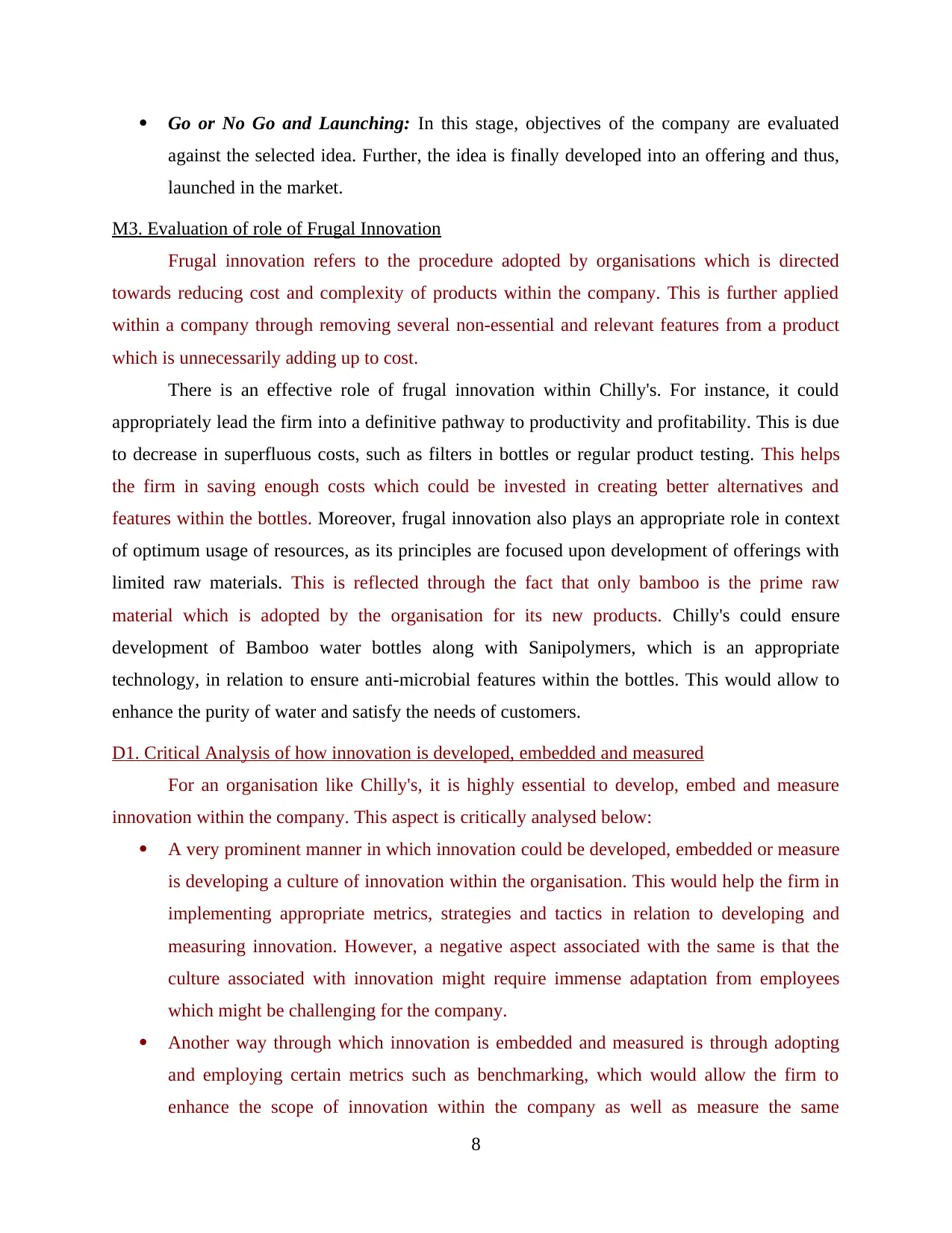
Go or No Go and Launching: In this stage, objectives of the company are evaluated
against the selected idea. Further, the idea is finally developed into an offering and thus,
launched in the market.
M3. Evaluation of role of Frugal Innovation
Frugal innovation refers to the procedure adopted by organisations which is directed
towards reducing cost and complexity of products within the company. This is further applied
within a company through removing several non-essential and relevant features from a product
which is unnecessarily adding up to cost.
There is an effective role of frugal innovation within Chilly's. For instance, it could
appropriately lead the firm into a definitive pathway to productivity and profitability. This is due
to decrease in superfluous costs, such as filters in bottles or regular product testing. This helps
the firm in saving enough costs which could be invested in creating better alternatives and
features within the bottles. Moreover, frugal innovation also plays an appropriate role in context
of optimum usage of resources, as its principles are focused upon development of offerings with
limited raw materials. This is reflected through the fact that only bamboo is the prime raw
material which is adopted by the organisation for its new products. Chilly's could ensure
development of Bamboo water bottles along with Sanipolymers, which is an appropriate
technology, in relation to ensure anti-microbial features within the bottles. This would allow to
enhance the purity of water and satisfy the needs of customers.
D1. Critical Analysis of how innovation is developed, embedded and measured
For an organisation like Chilly's, it is highly essential to develop, embed and measure
innovation within the company. This aspect is critically analysed below:
A very prominent manner in which innovation could be developed, embedded or measure
is developing a culture of innovation within the organisation. This would help the firm in
implementing appropriate metrics, strategies and tactics in relation to developing and
measuring innovation. However, a negative aspect associated with the same is that the
culture associated with innovation might require immense adaptation from employees
which might be challenging for the company.
Another way through which innovation is embedded and measured is through adopting
and employing certain metrics such as benchmarking, which would allow the firm to
enhance the scope of innovation within the company as well as measure the same
8
against the selected idea. Further, the idea is finally developed into an offering and thus,
launched in the market.
M3. Evaluation of role of Frugal Innovation
Frugal innovation refers to the procedure adopted by organisations which is directed
towards reducing cost and complexity of products within the company. This is further applied
within a company through removing several non-essential and relevant features from a product
which is unnecessarily adding up to cost.
There is an effective role of frugal innovation within Chilly's. For instance, it could
appropriately lead the firm into a definitive pathway to productivity and profitability. This is due
to decrease in superfluous costs, such as filters in bottles or regular product testing. This helps
the firm in saving enough costs which could be invested in creating better alternatives and
features within the bottles. Moreover, frugal innovation also plays an appropriate role in context
of optimum usage of resources, as its principles are focused upon development of offerings with
limited raw materials. This is reflected through the fact that only bamboo is the prime raw
material which is adopted by the organisation for its new products. Chilly's could ensure
development of Bamboo water bottles along with Sanipolymers, which is an appropriate
technology, in relation to ensure anti-microbial features within the bottles. This would allow to
enhance the purity of water and satisfy the needs of customers.
D1. Critical Analysis of how innovation is developed, embedded and measured
For an organisation like Chilly's, it is highly essential to develop, embed and measure
innovation within the company. This aspect is critically analysed below:
A very prominent manner in which innovation could be developed, embedded or measure
is developing a culture of innovation within the organisation. This would help the firm in
implementing appropriate metrics, strategies and tactics in relation to developing and
measuring innovation. However, a negative aspect associated with the same is that the
culture associated with innovation might require immense adaptation from employees
which might be challenging for the company.
Another way through which innovation is embedded and measured is through adopting
and employing certain metrics such as benchmarking, which would allow the firm to
enhance the scope of innovation within the company as well as measure the same
8
Paraphrase This Document
Need a fresh take? Get an instant paraphrase of this document with our AI Paraphraser
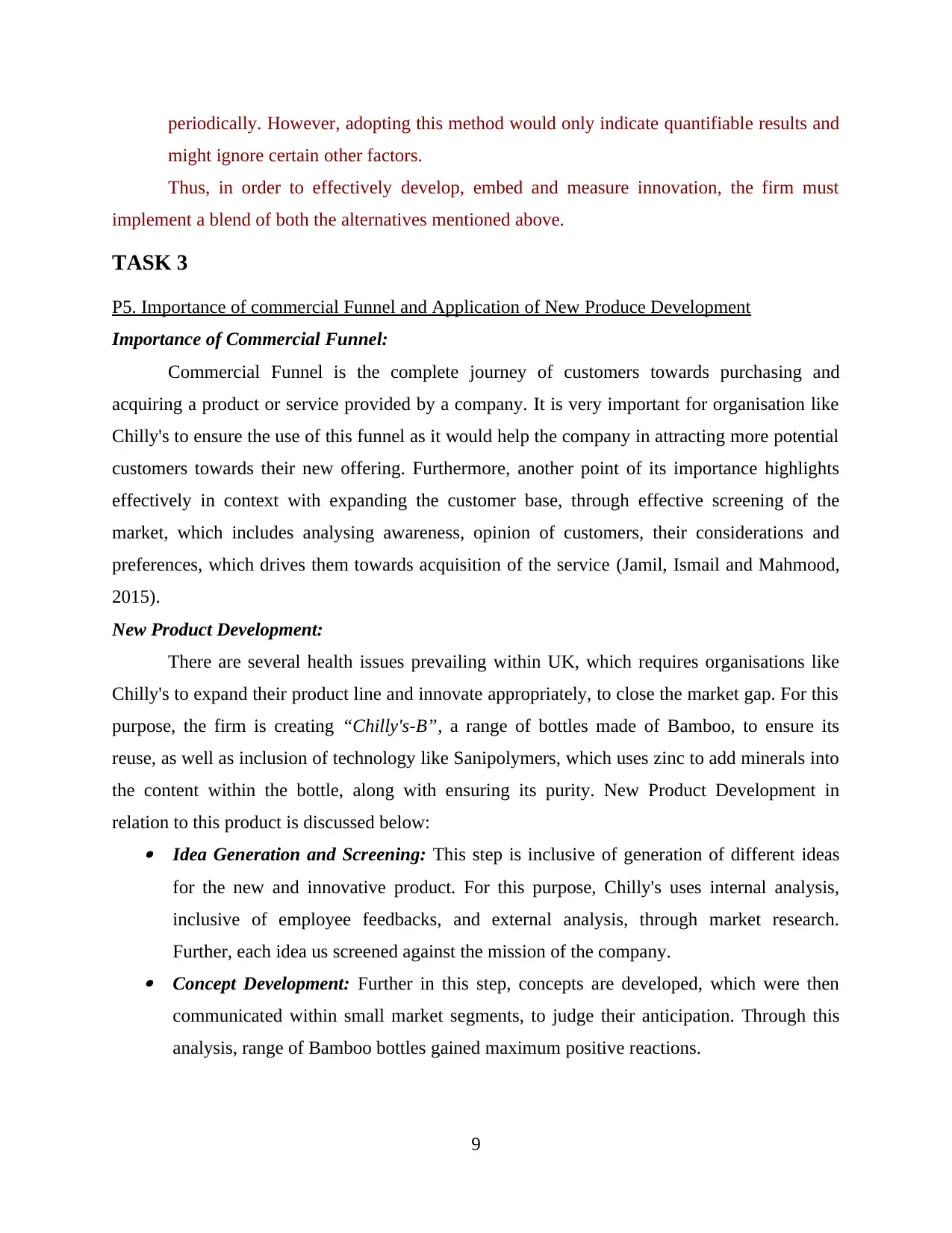
periodically. However, adopting this method would only indicate quantifiable results and
might ignore certain other factors.
Thus, in order to effectively develop, embed and measure innovation, the firm must
implement a blend of both the alternatives mentioned above.
TASK 3
P5. Importance of commercial Funnel and Application of New Produce Development
Importance of Commercial Funnel:
Commercial Funnel is the complete journey of customers towards purchasing and
acquiring a product or service provided by a company. It is very important for organisation like
Chilly's to ensure the use of this funnel as it would help the company in attracting more potential
customers towards their new offering. Furthermore, another point of its importance highlights
effectively in context with expanding the customer base, through effective screening of the
market, which includes analysing awareness, opinion of customers, their considerations and
preferences, which drives them towards acquisition of the service (Jamil, Ismail and Mahmood,
2015).
New Product Development:
There are several health issues prevailing within UK, which requires organisations like
Chilly's to expand their product line and innovate appropriately, to close the market gap. For this
purpose, the firm is creating “Chilly's-B”, a range of bottles made of Bamboo, to ensure its
reuse, as well as inclusion of technology like Sanipolymers, which uses zinc to add minerals into
the content within the bottle, along with ensuring its purity. New Product Development in
relation to this product is discussed below: Idea Generation and Screening: This step is inclusive of generation of different ideas
for the new and innovative product. For this purpose, Chilly's uses internal analysis,
inclusive of employee feedbacks, and external analysis, through market research.
Further, each idea us screened against the mission of the company. Concept Development: Further in this step, concepts are developed, which were then
communicated within small market segments, to judge their anticipation. Through this
analysis, range of Bamboo bottles gained maximum positive reactions.
9
might ignore certain other factors.
Thus, in order to effectively develop, embed and measure innovation, the firm must
implement a blend of both the alternatives mentioned above.
TASK 3
P5. Importance of commercial Funnel and Application of New Produce Development
Importance of Commercial Funnel:
Commercial Funnel is the complete journey of customers towards purchasing and
acquiring a product or service provided by a company. It is very important for organisation like
Chilly's to ensure the use of this funnel as it would help the company in attracting more potential
customers towards their new offering. Furthermore, another point of its importance highlights
effectively in context with expanding the customer base, through effective screening of the
market, which includes analysing awareness, opinion of customers, their considerations and
preferences, which drives them towards acquisition of the service (Jamil, Ismail and Mahmood,
2015).
New Product Development:
There are several health issues prevailing within UK, which requires organisations like
Chilly's to expand their product line and innovate appropriately, to close the market gap. For this
purpose, the firm is creating “Chilly's-B”, a range of bottles made of Bamboo, to ensure its
reuse, as well as inclusion of technology like Sanipolymers, which uses zinc to add minerals into
the content within the bottle, along with ensuring its purity. New Product Development in
relation to this product is discussed below: Idea Generation and Screening: This step is inclusive of generation of different ideas
for the new and innovative product. For this purpose, Chilly's uses internal analysis,
inclusive of employee feedbacks, and external analysis, through market research.
Further, each idea us screened against the mission of the company. Concept Development: Further in this step, concepts are developed, which were then
communicated within small market segments, to judge their anticipation. Through this
analysis, range of Bamboo bottles gained maximum positive reactions.
9
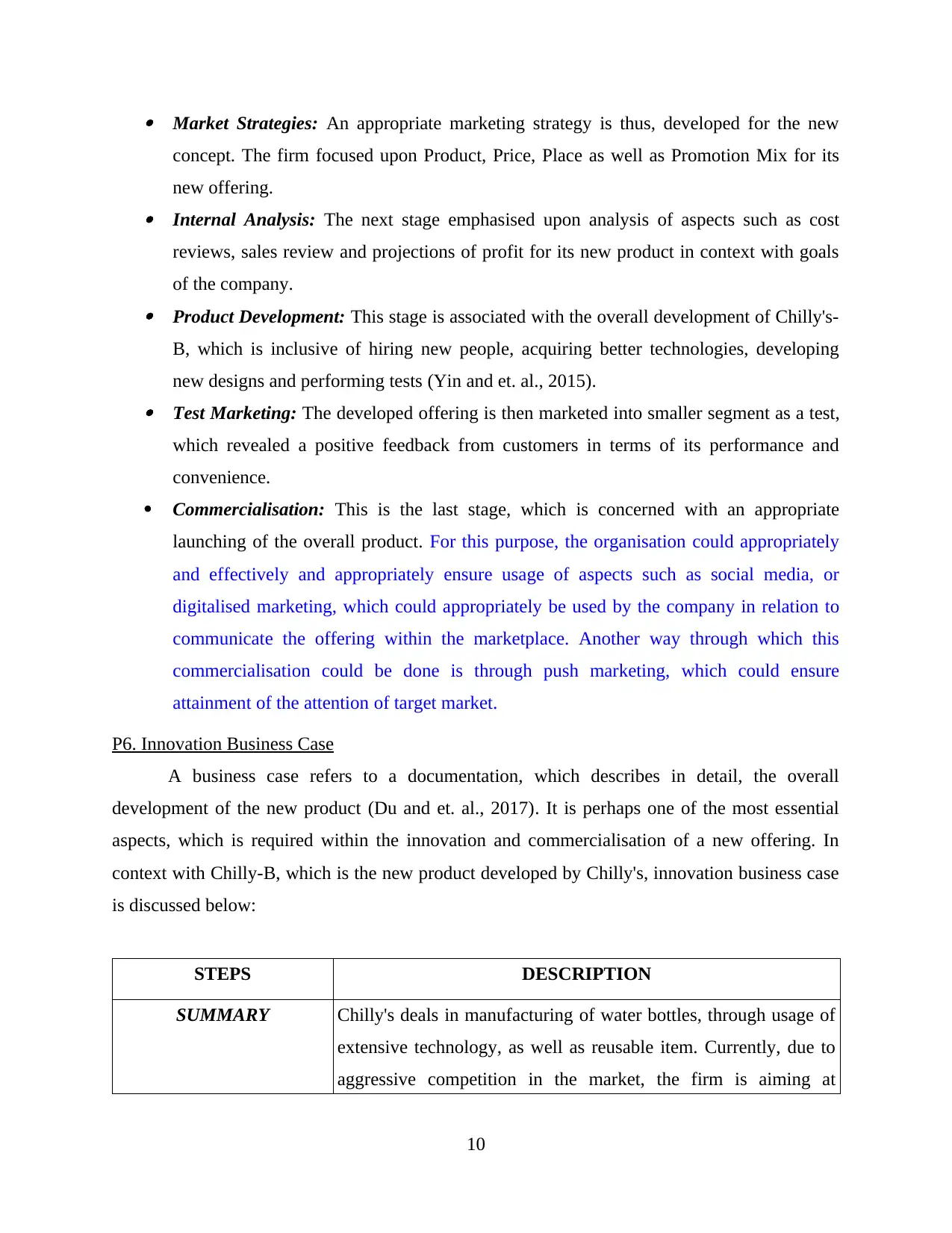
Market Strategies: An appropriate marketing strategy is thus, developed for the new
concept. The firm focused upon Product, Price, Place as well as Promotion Mix for its
new offering. Internal Analysis: The next stage emphasised upon analysis of aspects such as cost
reviews, sales review and projections of profit for its new product in context with goals
of the company. Product Development: This stage is associated with the overall development of Chilly's-
B, which is inclusive of hiring new people, acquiring better technologies, developing
new designs and performing tests (Yin and et. al., 2015). Test Marketing: The developed offering is then marketed into smaller segment as a test,
which revealed a positive feedback from customers in terms of its performance and
convenience.
Commercialisation: This is the last stage, which is concerned with an appropriate
launching of the overall product. For this purpose, the organisation could appropriately
and effectively and appropriately ensure usage of aspects such as social media, or
digitalised marketing, which could appropriately be used by the company in relation to
communicate the offering within the marketplace. Another way through which this
commercialisation could be done is through push marketing, which could ensure
attainment of the attention of target market.
P6. Innovation Business Case
A business case refers to a documentation, which describes in detail, the overall
development of the new product (Du and et. al., 2017). It is perhaps one of the most essential
aspects, which is required within the innovation and commercialisation of a new offering. In
context with Chilly-B, which is the new product developed by Chilly's, innovation business case
is discussed below:
STEPS DESCRIPTION
SUMMARY Chilly's deals in manufacturing of water bottles, through usage of
extensive technology, as well as reusable item. Currently, due to
aggressive competition in the market, the firm is aiming at
10
concept. The firm focused upon Product, Price, Place as well as Promotion Mix for its
new offering. Internal Analysis: The next stage emphasised upon analysis of aspects such as cost
reviews, sales review and projections of profit for its new product in context with goals
of the company. Product Development: This stage is associated with the overall development of Chilly's-
B, which is inclusive of hiring new people, acquiring better technologies, developing
new designs and performing tests (Yin and et. al., 2015). Test Marketing: The developed offering is then marketed into smaller segment as a test,
which revealed a positive feedback from customers in terms of its performance and
convenience.
Commercialisation: This is the last stage, which is concerned with an appropriate
launching of the overall product. For this purpose, the organisation could appropriately
and effectively and appropriately ensure usage of aspects such as social media, or
digitalised marketing, which could appropriately be used by the company in relation to
communicate the offering within the marketplace. Another way through which this
commercialisation could be done is through push marketing, which could ensure
attainment of the attention of target market.
P6. Innovation Business Case
A business case refers to a documentation, which describes in detail, the overall
development of the new product (Du and et. al., 2017). It is perhaps one of the most essential
aspects, which is required within the innovation and commercialisation of a new offering. In
context with Chilly-B, which is the new product developed by Chilly's, innovation business case
is discussed below:
STEPS DESCRIPTION
SUMMARY Chilly's deals in manufacturing of water bottles, through usage of
extensive technology, as well as reusable item. Currently, due to
aggressive competition in the market, the firm is aiming at
10
⊘ This is a preview!⊘
Do you want full access?
Subscribe today to unlock all pages.

Trusted by 1+ million students worldwide
1 out of 19
Related Documents
Your All-in-One AI-Powered Toolkit for Academic Success.
+13062052269
info@desklib.com
Available 24*7 on WhatsApp / Email
![[object Object]](/_next/static/media/star-bottom.7253800d.svg)
Unlock your academic potential
Copyright © 2020–2025 A2Z Services. All Rights Reserved. Developed and managed by ZUCOL.





